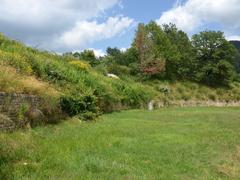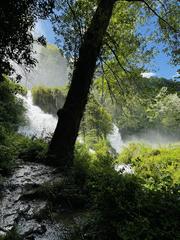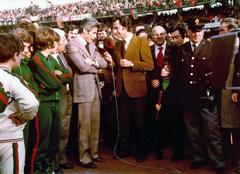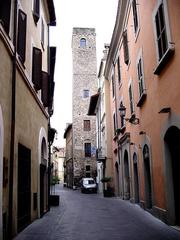
San Francesco Terni: Comprehensive Guide to Visiting Hours, Tickets, and Historical Highlights
Date: 04/07/2025
Introduction
Nestled in the heart of Umbria, the Church of San Francesco in Terni is a remarkable testament to centuries of Franciscan spirituality, architectural evolution, and vibrant artistic heritage. Founded in 1265 on a site associated with St. Francis of Assisi, the church embodies the religious and cultural spirit of medieval and Renaissance Italy. Its transformation from a modest oratory into an impressive example of Umbrian Gothic and Renaissance architecture—boasting treasures like the Paradisi Chapel’s frescoes and a bell tower adorned with colorful majolica tiles—makes San Francesco a must-visit destination for pilgrims, art enthusiasts, and history lovers.
This detailed guide will introduce you to the layered history of San Francesco, highlight its architectural and artistic marvels, and provide essential information on visiting hours, ticketing, accessibility, and travel tips. Whether planning a cultural excursion or a spiritual pilgrimage, you’ll find everything you need to enrich your visit to this treasured Umbrian landmark (Sharry.land; Umbria Tourism; Medioevo in Umbria).
1. Historical Overview
Origins and Foundation
The Church of San Francesco’s roots are intimately linked to the life of St. Francis of Assisi, who is believed to have visited Terni and found refuge at the oratory of St. Cassiano on this very site. The oratory, donated by Bishop Rainerio of Terni, became the seed of Franciscan presence in the city. Construction began in 1265 and continued through the 13th century, following the Franciscan ideal of simplicity with a single nave and transept for communal worship (Exploring Umbria; Wikipedia).
Expansion and Architectural Development
As the Franciscan community grew, the church underwent significant expansions, especially during the 14th and 15th centuries. Two side aisles were added in the early 15th century, creating a basilica plan. Materials for the expansion included local sponga stone and stones reclaimed from the nearby Arco del Fondanello. The gabled façade, Romanesque portal, and large oculus reflect both the region’s style and the Franciscan commitment to humility (Wikipedia IT).
Artistic Flourishing: The Paradisi Chapel
A highlight of San Francesco is the Paradisi Chapel, built in the early 15th century and decorated around 1450 by Bartolomeo di Tommaso. The frescoes, inspired by Dante’s Divine Comedy, depict the Last Judgment, Paradise, Hell, and the seven deadly sins. These works are considered among the finest examples of 15th-century Umbrian painting (Umbria Tourism).
Other notable artistic treasures include the Adoration of the Magi by Cesare Sermei and Sebastiano Flori’s Story of the True Cross frescoes (Wikipedia).
The Bell Tower and Exterior
The elegant bell tower, completed in 1445 by Antonio da Orvieto, is adorned with green and blue majolica tiles—an unusual and striking feature that sets it apart from other Franciscan churches of the region (Sharry.land).
Role in Local Religious Life
San Francesco has long served as a spiritual hub for Terni, hosting relics of Franciscan companions and acting as a focal point for local pilgrimages. The church’s central location and Franciscan roots made it a key site for religious gatherings, community events, and burials within its walls (Wikipedia IT).
Restoration and Modern Era
The church suffered damage during World War II, prompting significant restoration efforts to preserve its medieval and Renaissance character. Today, San Francesco is an active parish and a living monument to Terni’s spiritual and cultural heritage.
2. Architectural and Artistic Highlights
Interior Layout and Vaulting
The original single nave, expanded to three naves in the 15th century, features ribbed cross vaults supported by polystyle columns. The vaulting creates a dynamic play of light and shadow, enhancing the meditative atmosphere (Medioevo in Umbria).
Frescoes and Decorative Cycles
Noteworthy frescoes include:
- Blessed Simone Camporeali: Early 14th-century fresco, left lateral entrance.
- Maestro del Trittico di Terni: Christ and Pope Urban V, late 14th century, counter-facade.
- Votive Panels: Small 15th-century depictions of Saints Quintinus, Leonard, and a female martyr.
The Fourteenth-Century Pulpit
The unique 15th-century pulpit features an allegorical monstrous female figure, reflecting the didactic artistry of the era.
Architectural Relics
A large stone in the right nave marks the spot where St. Francis is said to have preached, connecting visitors directly with the saint’s legacy.
The Paradisi Chapel
The Paradisi Chapel’s frescoes are the church’s crowning artistic achievement:
- Inferno: Depicted as concentric ditches, following Dante.
- Purgatory: Seven ascending circles of soul purification.
- Paradise: Heavenly visions on the back wall.
- Prophets and Older Frescoes: Above the arch and as underlayers, respectively.
3. Visitor Information
Location and Getting There
- Address: Piazza San Francesco, 05100 Terni, Italy
- Access: Easily reached on foot from the city center; nearby parking and public transport are available (Comune di Terni).
Visiting Hours
- General Hours: Tuesday–Sunday, 9:00 AM–6:00 PM; closed Mondays and some holidays.
- Liturgical Services: Hours may vary with religious events. Check the official diocesan website or call +39 0744 425753 for the latest schedule (Orari Messe).
Tickets and Entry
- Admission: Free. Donations are appreciated. Special access (e.g., Paradisi Chapel, concerts) may require a small fee.
Guided Tours
- Availability: Arrange through the parish or local tourism offices. Small group sizes ensure a personalized experience.
- Languages: Tours are available in multiple languages upon request.
Accessibility
- Mobility: The main entrance and nave are accessible. Some areas (side chapels, bell tower) may have steps or uneven floors. Contact the parish in advance for specific accommodations.
Facilities
- Amenities: Basic amenities nearby; restrooms at local cafes. Occasional souvenir kiosks inside the church.
- Photography: Allowed in most areas (no flash/tripods); restrictions during services and in Paradisi Chapel.
4. Travel Tips and Nearby Attractions
- Combine Visits: San Francesco is close to the Roman amphitheater, Terni’s cathedral, and archaeological museum.
- Ideal Times: Early mornings or late afternoons are quieter.
- Dress Code: Shoulders and knees covered. Silence is appreciated during services.
- Festivals: The church plays a central role in citywide events, especially around St. Francis’ feast (October 4) and St. Valentine’s Day (Over Your Place).
5. Frequently Asked Questions (FAQ)
What are the San Francesco Terni visiting hours?
Tuesday–Sunday, 9:00 AM–6:00 PM; closed Mondays and holidays. Check here for updates.
Is there an entry fee?
Entry is free; donations welcome. Special events or tours may have a small fee.
Are guided tours available?
Yes, by arrangement through the parish or local tourist offices.
Is the church accessible for people with disabilities?
The main areas are accessible; some historic areas may be challenging. Contact +39 0744 425753 for support.
Can I take photos inside?
Yes, except during services and in some chapels. No flash or tripods.
6. Visual Highlights
(For best experience, refer to official tourism websites for high-quality images and virtual tours.)
- Exterior: Gothic façade with pointed portal and oculus.
- Paradisi Chapel: Vivid Last Judgment frescoes.
- Bell Tower: Distinctive majolica tiles.
- Nave: Ribbed vaults, polystyle columns.
7. Conclusion
The Church of San Francesco in Terni stands as an extraordinary narrative of faith, art, and architecture—spanning more than seven centuries. Its architectural features, from the ribbed vaults and elegant bell tower to the Paradisi Chapel’s frescoes, offer a rich immersion into Umbrian religious and artistic tradition. Welcoming to all, with free admission and guided tours, San Francesco is both a serene spiritual haven and a gateway to Terni’s historic heart.
Plan ahead by checking visiting hours and events, consider exploring nearby sites, and enhance your journey with resources like the Audiala app for curated guides and updates. Whether for art, history, or reflection, San Francesco is an unmissable highlight of Umbria.




